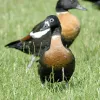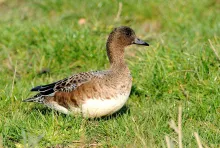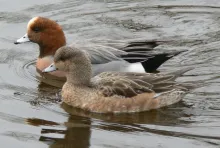
Eurasian Wigeon (Mareca penelope)
Species name
- Dutch name:
- Smient
- English name:
- Wigeon
- German name:
- Pfeifente
- French name:
- Canard siffleur
- Scientific name:
- Mareca penelope
Scientific classification
- Order:
- Anseriformes
- Family:
- Anatidae
- Onderfamilie:
- Anatinae
- Genus:
- Mareca
Description
- Description:
Male:
Have a black-speckled russet-red neck and head topped with a cream stripe. The breast is grayish-pink and the lower breast, belly and sides of the rear body behind the flanks are white. The flanks are finely vermiculated and appear gray. In flight, a white shoulder patch and green speculum are displayed. The bill is blue-gray with a black tip and the legs and feet are blue-gray.Female:
Have gray-brown-to-russet-brown heads, necks, chests, backs, sides and flanks. The bill is blue-gray with a black tip and the legs and feet are blue-gray.
Standard Measurements
- Body Length (cm):
- The male (drake) of the Eurasian Wigeon measures approximately 46-51 centimeters. The female measures approximately 46-51 centimeters.
- Body Weight (grams):
- The male will weight about 635-1090 gram. The female will weight about 635-1090 gram.
The weight is notoriously variable and can only be used as indication!
- Habitat:
When breeding, concentrated in boreal and subarctic zones with slight overlap into temperate and fairly numerous occurrences, often sporadic, in steppe zone. Prefers shallow, open, broad, fresh waters, of medium quality, neither strongly eutrophic nor oligotrophic, with ample submerged or floating vegetation but without dense, emergent or marginal stands. Predominantly lowland, within continental climatic zone; tolerant of open woodland and preferring wooded to open tundra, but thinning out towards dense forest and mountains. Uses good nesting cover in coniferous or deciduous wooded areas, as well as steppes, both near and fairly distant from water. Avoidance of extreme arctic climates permits early summer occupancy of breeding grounds and early departure, with rapid return movement in early autumn.
Winter habitat mainly in oceanic climates, lowland and largely maritime, especially along coasts where shallow, fairly sheltered waters and extensive tracts of tidal mud, sand, or salt-marsh offer sustenance and security for gatherings. Freshwater and brackish lagoons, and tracts of flooded grassland also attractive, and may be used in preference to coastal waters.
- Note:
They nest on the ground under dense vegetation, usually near water. The nest is a shallow depression lined with grass and down. The young leave the nest and head for water shortly after hatching.
- Breeding:
- The female Eurasian Wigeon usually lays from 6-10 cream-white eggs and incubates them for 24-25 days.
- Artificial incubating:
The ideal relative humidity for incubating most waterfowl eggs is 55% (ground nesters) and 40% (cavity nesters). The temperature is usually 37.4°C. Set ventilation as recommended by the incubator manufacturer. Eggs must be turned, either automatically or by hand, a minimum of 4 times a day. As the duckling develops there is a loss of water from the egg and the air sac gets bigger. In normal development of an egg with a 24-25 days incubation, the air sac occupies about a third of it three days earlier. Cleanliness is vital and ideally eggs should be moved to a separate hatcher at this point, where the humidity should be increased to 65% and even higher once they have pipped internally.
- Bird banding:
- Recommended closed leg band ring size for the Eurasian Wigeon is 9 mm.The leg band ring can only be applied on a young dabbling duck at around 11-12 days old.
- It doesn't matter what leg that you band, but it's good to have a consistent system. Suggested: Left leg = Female, Right leg = Male
- Maintenance food:
-





Floating full food for all sea ducks, green ducks, eider ducks and geese, especially in the moulting and breeding phase ideally suited. Packed with wholesome raw materials, natural vitamins and trace elements, this performance food with a protein content of 30% forms the basis for lifelong vitality.
- Regulation:
- Europese soort
- Regulation:
Het is niet verboden om deze vogels te houden die van nature in Nederland voorkomen, op voorwaarde dat deze vogels in gevangenschap zijn geboren; nakweek dus. Deze vogels zijn voorzien van een gesloten pootring. Het is wel verboden om deze vogels te houden die in het wild gevangen zijn. Alleen bepaalde instanties, zoals vogelasiels en vogelhospitalen, zijn bevoegd om jonge en gewonde wilde vogels te houden. Deze bescherming van vogels wordt vormgegeven door schadelijke handelingen te verbieden zoals:het doden, verwonden, vangen, bemachtigen en met het oog daarop opsporen van vogels (art. 9 Flora- en faunawet); het opzettelijk verontrusten van vogels (art. 10 Flora- en faunawet);het beschadigen, vernielen, uithalen, wegnemen en verstoren van nesten, holen of andere voortplantings- of vaste rust- of verblijfplaatsen van vogels (art. 11 Flora- en faunawet);en het zoeken, rapen, uit het nest nemen, beschadigen of vernielen van eieren van vogels (art. 12 Flora- en faunawet).



